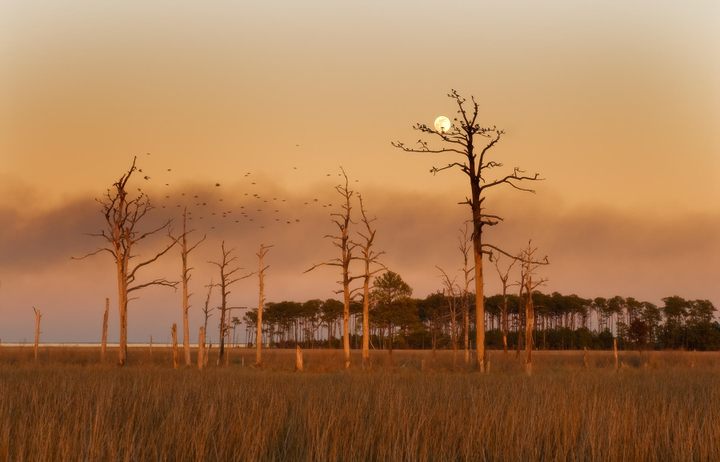
The Haunting Ghost Forests of Maryland’s Eastern Shore
Rising seas are claiming land, changing lives, and transforming our relationship with nature.
To cull the dead trees, Lin Spicer had to drive his tree cutter onto a treacherous stretch. Some of the pines he could almost have pushed over with his hands, there was that little holding them to the marshy flat of the Blackwater National Wildlife Refuge, on Maryland’s Eastern Shore. Needles long fallen, bark sloughed off, these stands of trees resemble fleets of ship masts slanted along the water’s edge. Spicer was riding among them on his tractor-sized machine, when he found that he was sinking down, down, down, and he thought, “I’m going in the wrong direction here.”
Spicer is a seasoned timber man, and he would not have taken his cutter out onto such a sodden stretch, except that the managers and scientists at the refuge had hired him to fell the dead trees covering these acres: a ghost forest. Now he was that close to losing the cutter, until it caught hold of a stump and he felt it rising back up.
“Wow, that was a close call,” he remembered later, crammed into the backseat of a dark green pick-up truck. Spicer has a rounded nose and a long, tanned face, and he was grinning under a brown cap. Even now, he did not quite get the reasoning of the people who’d caused him to risk his cutter. It had to do with birds, as far as he understood, that would not fly through the dead snags. “It never did make a whole lot of sense to me,” Spicer said. “Everywhere you look there’s standing dead trees.”
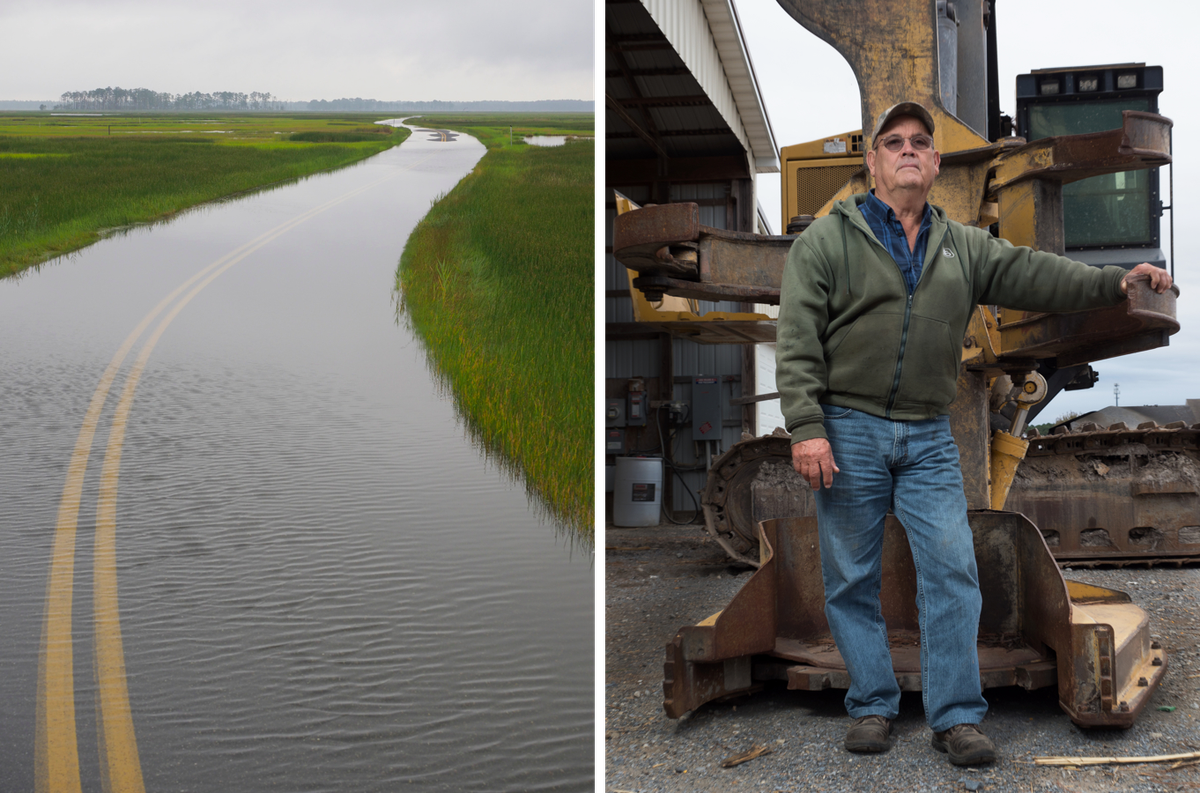
All afternoon, Spicer, along with Elizabeth Hill, the chairperson of the Dorchester County forestry board, and Scott Daniels, the blue-eyed county forester, had been showing me the extent of the damage. In some stretches of the woods here, all the trees are dead—still standing, but dead, every one, as if they had been cursed. The road we started down cut through ranks of loblolly pines, healthy, tall, and straight, reinforced with oaks and sweetgums and red maples. But then, at intervals, this seemingly healthy growth gave way to wide-open areas studded with the silver trunks of dead or dying trees, some broken, jagged, in half. One step off the road would have sunken us into brine-soaked marsh, even soggier than the kind that almost ate Spicer’s cutter.
Daniels has worked in Dorchester for more than three decades, long enough for his hair to thin and soft wrinkles to cross his face, and part of his job is to help people with small plots manage their timber. In the past 15 years or so, he’s been getting more and more calls from landowners asking him what could be wrong with their trees. When I first asked him about seeing a ghost forest, he immediately told me to come to Dorchester. It is low-lying land, veined with waterways, that fades straight into the Chesapeake Bay. As the level of oceans and seas and bays around the world inches upward, the rising table of salt water is having a devastating effect on the county’s forests.
In Dorchester, timber has been a major industry for generations, and a stretch of land might pass from parent to child or grandchild like a family heirloom: A crop of loblolly pine harvested at the right moment might fund a college education or years of retirement. Ceding a plot to salt marsh can be an unsettling loss. From the spot where Spicer almost lost his cutter, we drove to a piece of property that his family has owned and managed for, at his best guess, 150 years. He pointed out one stand that had last been cut in the mid-1940s, about 70 years ago, and that wouldn’t be harvested again for a while yet.
“It’s my granddaughter’s,” he said. “She’ll be the one that reaps the benefit. Just as I’m reaping my grandfather’s.”
Is it a spoiler to say that the trees aren’t going to make it? Because it’s clear by now where this story is going. Sea-level rise is a slow-moving calamity, and the trees here are among its early victims. Ghost forests like these are appearing up and down the eastern seaboard of North America, from Florida, through the Carolinas, Virginia, Maryland, and New Jersey, on into Canada. “The ghost forests are the best indicator of climate change on the East Coast for sure, and one of the best anywhere,” says Matt Kirwan, a coastal geomorphologist at the Virginia Institute of Marine Science. “They’re right up there with melting glaciers, and they’re forming at faster and faster rates.”
When scientists and climate activists describe the marks left by climate change—the land lost, the people displaced, the ecosystems irrevocably altered—Dorchester County is one of the places they’re talking about. On maps projecting the progress of water upland, the Eastern Shore starts to erode into an expanse of blue. Critical carbon thresholds, thousand-year floods, climate refugees, doomsday: What they mean, in the language of wind, water, earth, and air, is that the salty bay will seep over this land until it’s not land any more.
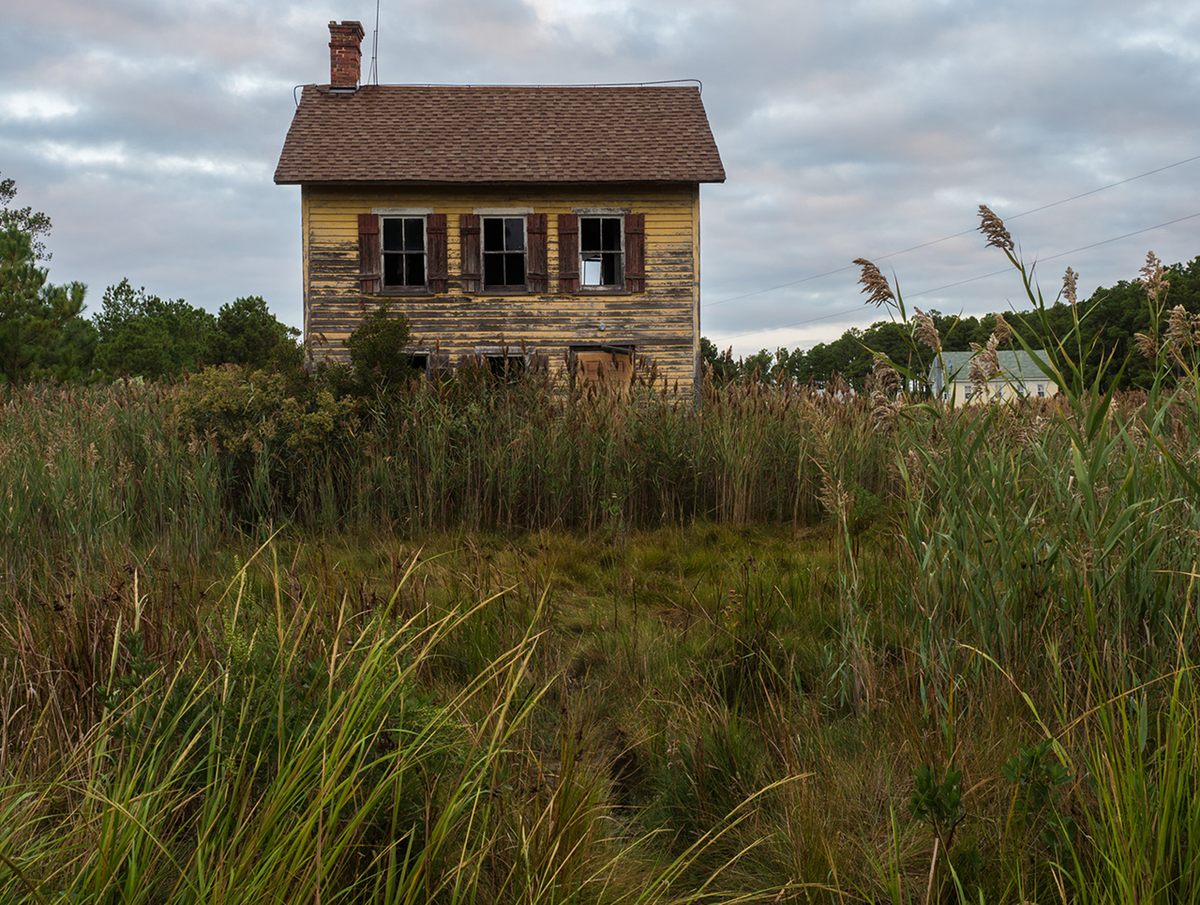
The imagery here can be almost too much: a sunken, weather-beaten shack, a trio of dark vultures lined up along the roof, fields of skeletal trees against dark, forbidding water. It looks like an apocalyptic fantasy, but at times, this place is still alive with people. When I visited in the fall, the county’s largest city was preparing to host an Iron Man Triathlon, and in the right season the backroads are crowded with the parked cars of hunters seeking spotted sika deer, originally from Japan and imported decades ago. Properties that flood regularly still sell at respectable prices—as hunting cabins rather than full-time homes. Even as people who’ve lived here their whole lives plan their retreats, newcomers set up camp and hold on, however provisionally.
This place has been shaped by centuries of haphazard human intervention, and will be again as the coastline evolves. Climate change will inevitably morph this land from what it was into something else entirely, but a small group of people is looking for ways to guide this transformation. When scientists and conservationists sent Spicer to take down that stretch of ghost forest, it was because they are now considering the benefits of letting the marsh claim what used to be forest—of helping change along instead of holding it at bay.
Living on land that has always been prone to flooding, that never quite seems to hold its shape, where tides matter and people pay attention to the direction of the wind, some don’t believe that man-made climate change is remaking the landscape they’ve always known. When the wind hits from a certain direction, and the tide’s pushed far out, decades-old stumps dot the marsh. The water’s incursion might be speeding up, they agree, but its assault on the forest has been happening for generations. On a country road I stopped to ask a man with mottled skin and close-set eyes about the dead trees beyond his house; he said that he’d lived in Dorchester all his life, and “not much has changed.”
“I suppose it’s been going on since the beginning of time, but I think it’s accelerated in the last 20 years,” Spicer said, looking out toward a stretch of ghost forest on the edge of the refuge. “I really do think it has speeded up, just exactly what you see right there. The fringe timber keeps moving inland all the time.”
The Eastern Shore of Maryland is part of the expansive Delmarva Peninsula, which starts in Delaware’s northern reaches and tapers to a point about 30 miles northeast of Virginia Beach. The ancient dunes that underlie the peninsula began forming millions years ago, as a supersized barrier island. Ocean currents swept the eroded grit of the Appalachian Mountains along the continent’s edge, and over time, this sediment forced the ancient Susquehanna River to the west. When glaciers melted out at the end of the last Ice Age, a short 10,000 years ago, they drowned the river valley and formed the Chesapeake Bay.
Dorchester is located on the bayside of the giant spit, and all over there are remnants of its human past. The woods hide mounds of old sawdust where mills used to be, and ditches that had been dug to corral the tide. Some of the farms here have been managed since the 1600s. This is the place Harriet Tubman escaped from and returned to, again and again, as a guide for those who wanted to go north. Along the narrow county roads, some of the slouching buildings are old canneries, going back to the years before World War II, when farmers here grew water-hungry tomatoes.

In southern Dorchester, over time, the fields went fallow. The push of the salt water was insistent, and farms were given back over to forest. As the groundwater grew saltier, tree seedlings wouldn’t thrive, either. Older trees, weakened by salt stress, might die early, or succumb to infestations they’d otherwise fight off, so while some ghost forests develop slowly, others appear somewhat suddenly. Daniels, the county forester, drove us down to a small, white church in the county’s southern half. Behind it was a field of trees stressed by salt water, but done in by pine beetles. Their needles were flushed bright red in death.
“Hundreds of acres of this, and yet nobody called,” Daniels said. Once, he spent most of his time down in this part of the territory, but now there’s little he can recommend that might help people there. “You look at aerial photographs,” he said, “and you can see how the marsh encroached on these woods in the past 30 or 40 years.”
As we headed to the next stretch of ghost forest, we passed by flooded yards and abandoned houses, “For Sale” signs hung by the road. The cab of the truck was quiet. “It’s hard to see some of that stuff, really,” said Hill, chair of the county local forestry board. “I mean, I’d be sick if that was my land. It’s devastating.”
Daniels hesitated before fording a creek that had spilled over the road. But he went ahead, and then stopped at the road’s next junction. The house on the corner, a stately place with gray gables that someone had tried to turn into a bed and breakfast, stood in a small, shallow pond, fed by the overflow from roadside ditches. Before us, in every direction, the water was too deep to keep going.
Matt Kirwan’s great-grandparents were married in a little white church not far from the refuge, now next to a sprawling ghost forest. His family used to farm corn, until the ground grew too salty. The cornfields then grew into tracts of trees, and they’re now a ghost forest, too.
Kirwan, the geomorphologist, studies the processes that shape coastal lands, and he has spent years trying to understand the movements of marshes. He comes to Dorchester to hunt and trap, but he is one of the only people from his line of descent, going back centuries, who did not grow up here. His dad left, for a variety of reasons, but later bought back property that had been in the family for a hundred or so years. In this part of the world people trap fat and fluffy muskrats and capture predatory, invasive snakehead fish in murky waters, but the real prize is those sika deer. “I’ll be sitting in my deer stand with stars everywhere, and hear this beautiful whistle noise,” Kirwan said. Like much larger elk, the bucks bugle, and he often hears them right before daybreak. “You’re listening to this buck, and another one answers.”
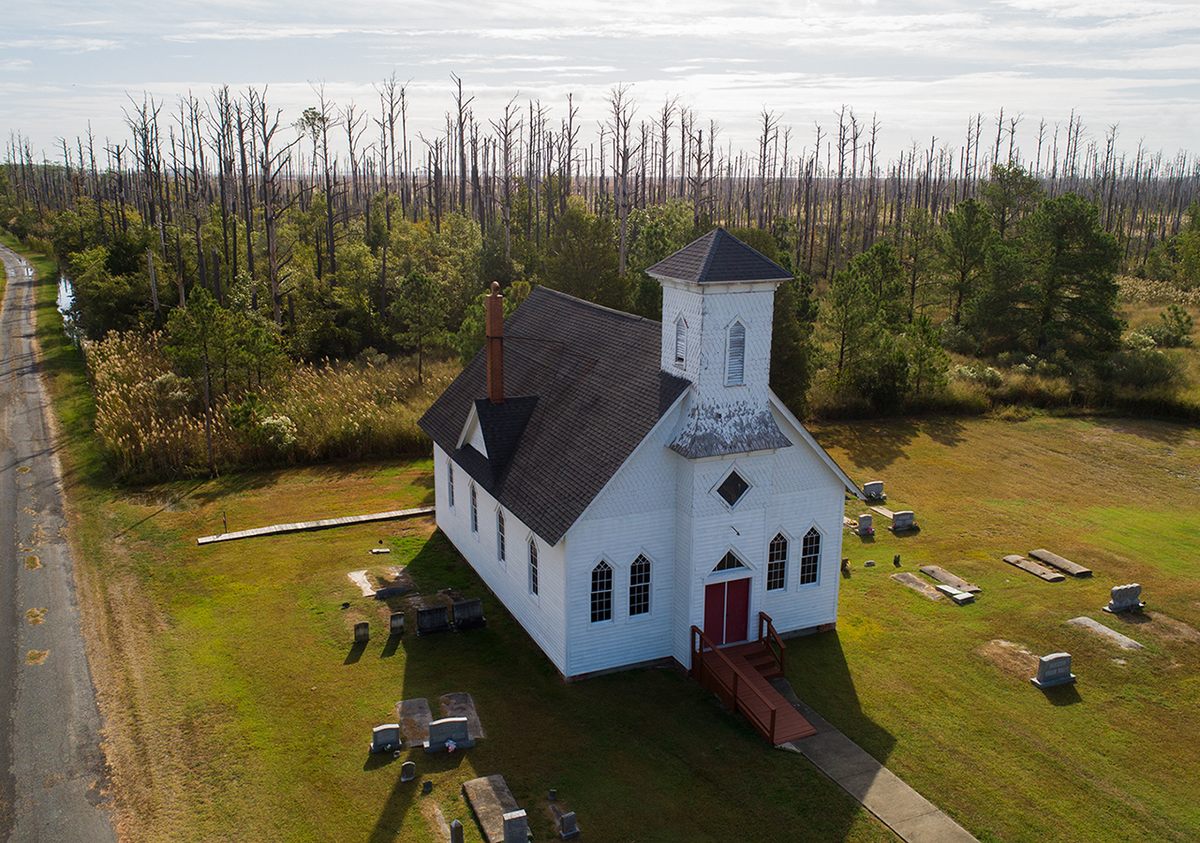
Sitting in the deer stand on his family’s property, one season after another, Kirwan saw how the trees thinned and began to die off, the fastest-changing features of the landscape. It was less obvious from where he was sitting how the once-dry ground was giving way to wetlands—how the forest would become a watery expanse riddled with bobbing cattails and the tough triangular shoots of bayonet grass.
Coastal marshes often look different from one day to the next, depending on rain and tide, but once established they can remain surprisingly stable for thousands upon thousands of years. They form when sea level rise is slow; the supple grasses slow the rushing tide, letting sediment settle, so that when they’re flooded the marsh actually builds. Even as sea level rise accelerates, they can continue to accrete—up to a point, at least.
“Most ecosystems don’t have the ability to fight that kind of change,” Kirwan said. Flood a forest, and it drowns; flood a marsh, and it grows. They were made for the unpredictable. “Most people think of wetlands as fragile ecosystems where if you mess with it just a little bit, it’s going to disappear forever. But that’s not the case.”
There are limits to this tenacity and adaptability. Severe, repeated, or prolonged flooding—and the salty groundwater that comes with it—can kill the plants, loosening the marsh’s hold. Once that starts happening, marshes begin to break up and merge with the ocean. To survive, what grasses are left must migrate to higher, newly soggy ground. Whatever was in that once-higher ground—that becomes marsh. That’s how ghost forests grow. They are almost-marshes, marshes-to-be, sacrifices to a displaced ecosystem.
Waterlogged ground is no place for people to build a life. When marshes move, “It’s bad for coastal communities,” Kirwan said. “A big part of me feels bad when I see all the trees on my dad’s property are dying.” But he also understands that ceding ground to the marsh could have a purpose. Marshes, wherever they exist, are one of the most significant ecosystems in the world. They protect us from flooding. They blunt erosion and cushion the impact of storms. They nurture the base of the food chain and filter out chemicals that would otherwise flow straight into the ocean. They can be considered more important ecologically than even a healthy forest.
Kirwan is of two minds about the marsh’s migration inland. As a person who has a relationship to land, he said, “I’m extremely torn.” As a scientist, however, his stance is unequivocal: “I view it as a win.”
For a decade now, Kirwan has been studying marshlands, trying to understand their mechanisms, their strengths, their weaknesses. It’s easy to assume that coastal wetlands would be goners when the sea rises to consume them. But they might have a chance. In 2018 Kirwan, along with a group of other scientists, wrote in Nature that “rather than being an inevitable consequence of global sea-level rise … large-scale loss of coastal wetlands might be avoidable.” Long-cultivated loblolly pine forests might fade away. But the marshes could last, “even prosper,” the scientists wrote. These ecosystems just need the space to move inland in advance of the sea. Their future depends on how much we are willing to cede to them.
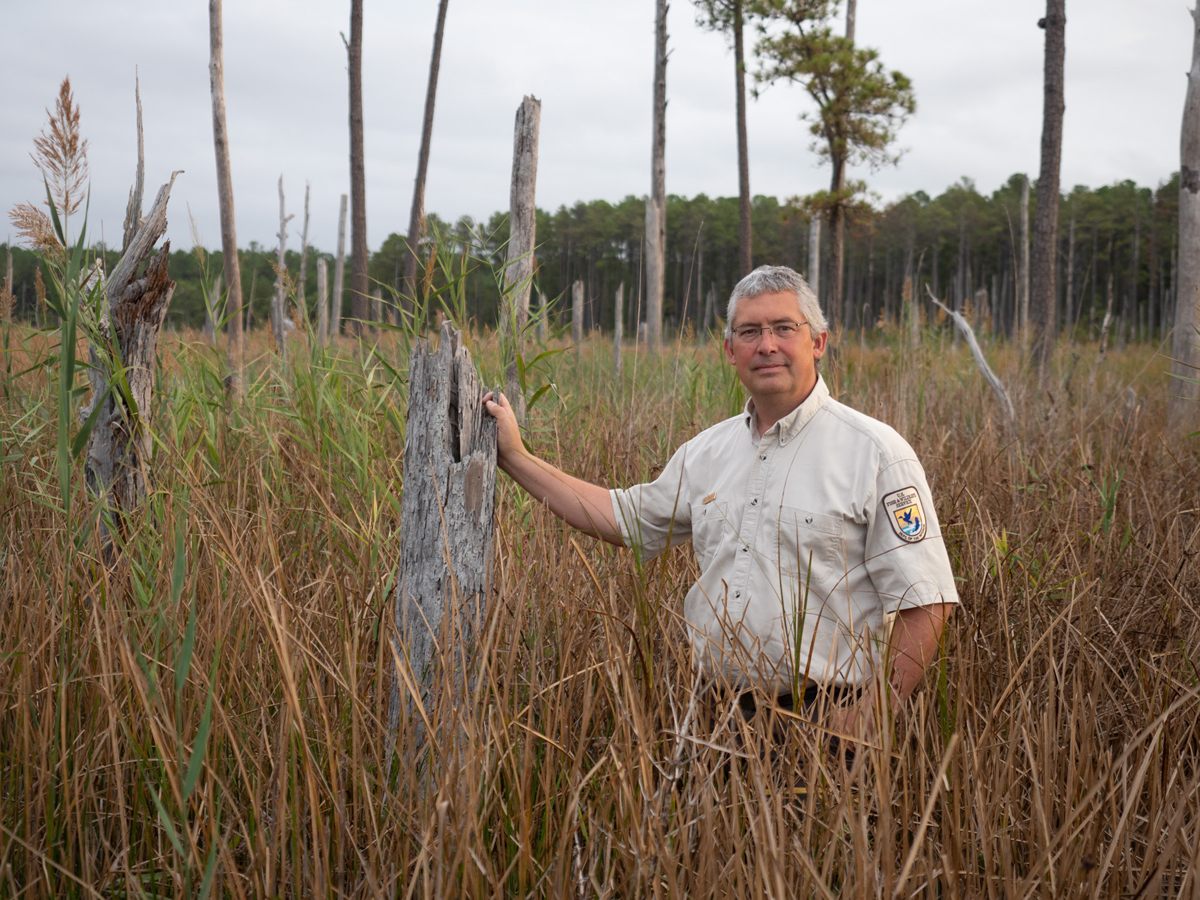
Once, marshes were protected because they attract birds, which attract hunters. Miles inland from Dorchester’s coastline, the Blackwater River pools through the 30,000 acres of the Blackwater National Wildlife Refuge, created in 1933 for the benefit of migrating ducks and geese. It contains a full third of Maryland’s tidal wetlands. At high tide, in the refuge’s heart, water laps over the edges of the road and can cover it completely. Berms just a few inches above the surrounding land pass as high ground, but every view is still an expanse holding the deep blue of the water, the light blue of the sky, the green line of grass and tree where they meet.
In this place, creatures such as salt marsh sparrows and clapper rails, diamondback terrapins, seaside dragonlets, and salt marsh skipper butterflies have found a way to make life work. “It’s just a beautiful place,” said Matt Whitbeck, the refuge’s supervisory wildlife biologist, standing on a wooden platform overlooking the river. “It’s not water, it’s not land, it’s an in-between place.” Whitbeck came to the mid-Atlantic after years at the Anahuac National Wildlife Refuge on Galveston Bay, Texas, an estuarine setting of bayous and marshlands. His heart’s long been in the tide.
“You come here, and it’s beautiful,” he said, “but understanding what happened, it’s kind of devastating, you know? This was all tidal marsh. This is an example of marsh converting into open water.”
All around the platform, small circles of blue hid in the grass—pockets of open water breaking up the marsh. This is the marsh’s equivalent of a ghost forest: patches of drowned marsh, where the plants have died and their roots lost their grip on the sediment—and then open water has taken over. As the patches grow, wind kicks up waves, which exacerbates the erosion and opens them further. Marsh becomes bay just as, at the edge of the view, forest becomes marsh.
As the refuge’s wildlife biologist, Whitbeck’s job is to help maintain its habitats, best he can, for the fish and birds and plants and other wildlife within its bounds. For many years, conservation of this sort has meant projects such as attempting to eradicate the invasive phragmites grass that’s now ubiquitous here. The goal has been to resurrect nature’s past. In Dorchester that would require going back almost as far as the history of lasting European settlement in the mid-Atlantic, to the 1630s, when hardwoods dominated the Eastern Shore. People in Dorchester are used to thinking on the long timescales of timber plots and multigenerational drama, but three generations from now, this place will be transformed. To protect habitat for all the creatures that need the refuge’s marshes, Whitbeck cannot hope to restore any one spot to what it once was. “We have to think about not so much where the marshes are now, but where they are going, and how to accommodate that change,” he said.
It’s hard to understate how big a shift this represents in how public land managers do their work. It means that some human choices and their effects can’t be undone. It means letting go of the ideal of restoration, and detaching the goals of conservation from a particular geographical point.

At Blackwater, it means accepting that the marsh is migrating and taking actions to ease its path, even if that requires sacrificing forestland. As part of a planning exercise a few years back, a team of scientists predicted what the marsh’s spread would look like by through 2050 and 2100, just beyond the average life expectancy for an American born today. This map now guides decisions large and small. As Dorchester’s aging farmers and foresters look to cash out, they often try to sell their property to the refuge. The land managers then consult the map, and only recommend the refuge buy land that fits into the larger plan guiding the marsh’s migration upland. They’re essentially investing in marsh futures.
Within the marsh, a coalition of scientists and environmental groups, including the Conservation Fund, Nature Conservancy, and Audubon Society, are conducting small experiments to see what more they can do to ease the marsh’s path. The job that Lin Spicer did, clearing away those dead trees from a damp stretch of land, was part of that work. Most salt marsh birds will not nest near a stand of dead trees, where predators might lurk. Living there would be akin to settling in a city of burnt-out skyscrapers, occupied by dangerous gangs. Cutting the trees down, the thinking goes, could expand the habitat for marsh birds. Simultaneously it allows the scientists to investigate the impact that removing the dead trees will have on the height of the marsh. Trees or no trees—which is better for keeping the open water at bay?
David Curson, of Audubon Maryland-DC, compares the role they’re playing to that of master gardeners. “We appreciate natural processes but we need to intervene,” he says. “Landscapes are changing faster, and it’s our fault. We need to get involved and play god a little bit.” Whitbeck describes the shift from restoring the past to planning the future, as “revolutionary.” In this way of thinking, the refuge still needs to maintain habitat for the birds and fish and plants and the other wildlife—but that habitat doesn’t have to be in the same place as it was 400 years ago, 100 years ago, or even 10 years ago. It just needs to exist, somewhere.
This could work here because the refuge is giving the marsh somewhere to go. In other parts of the world, wetlands are disappearing because people have erected seawalls and dykes, which mean land and water are separated by a clear dividing line, and there’s no place for wetlands in between. On the Atlantic coast of the United States, these barriers are more haphazard, and the decisions to erect them often made by individual landowners, who don’t necessarily see the value in maintaining wetlands on their property.

The longer I spent in Dorchester County, the more the ghost forests came to seem unremarkable. I stopped seeing them everywhere, because they are indeed everywhere, and they no longer registered as small horrors. The marsh that had killed these trees is no villain in this drama. People have altered this landscape in so many ways—with the sika deer, the ugly snakeheads in roadside ditches, the reedy, weedy phragmites—that no other landscape like this has existed on Earth before. Many small human decisions made it this way, and many small human decisions will remake it all over again. Now is the in-between time for this in-between place. It’s clear that change has come; only the shape it will take is still uncertain.


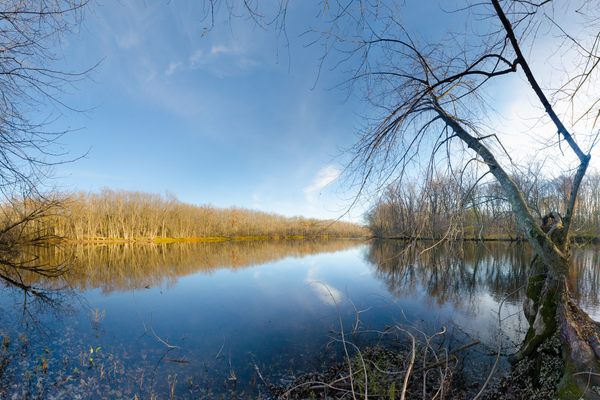












Follow us on Twitter to get the latest on the world's hidden wonders.
Like us on Facebook to get the latest on the world's hidden wonders.
Follow us on Twitter Like us on Facebook